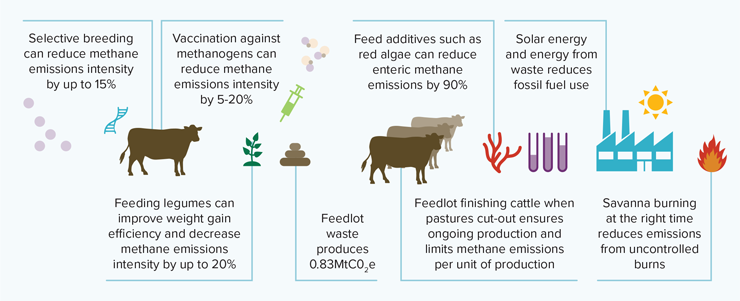66 3 from enteric fermentation in ruminant livestock eructation and flatulence 15 5 from agricultural soils. Global livestock production contributes an estimated 18 of anthropogenic greenhouse gas ghg emissions mainly in terms of methane and nitrous oxide.
Feeding Seaweed To Cows Csiro Livestock Methane Research Lights Up Beef Central
More than 40 million hectares of grazing land adopt savanna burning management methods creating more than 10 million carbon credits per year.

Livestock greenhouse gas emissions australia. Agriculture was responsible for about 16 of australia s greenhouse gas emissions in 2013 and the sources see table 1 are. Australia s greenhouse gas emissions have increased for the past three years reaching 556 4 mtco 2e in the year to december 2017. Livestock are the dominant source of methane ch 4 and nitrous oxide n 2 o accounting for 56 and 73 respectively of australia s emissions.
In australia direct livestock emissions account for about 70 of greenhouse gas emissions by the agricultural sector and 11 of total national greenhouse gas emissions. Dr windsor said as large ruminant production was associated with high outputs of greenhouse gas emissions it was estimated improved production efficiencies could potentially reduce global. Enteric fermentation from livestock amounts to 6 2 gt of co2 equivalents 4 4 of global emissions.
Around 30 of this is household food and garden waste equivalent to around 1 5 tonnes of greenhouse gas per household each year. Eight of australia s major sectors are responsible for australia s rising emissions. This makes australia s livestock the third largest source of greenhouse gas emissions after the energy and transport sectors.
Methane and nitrous oxide are significant greenhouse gases as they have much greater global warming potential than carbon dioxide. P sectoral trends since 1990 australia s emissions have decreased by 10 9 per cent 66 0 mt co 46tr 2 r46t e since 1990 reaching 538 9 mt co 46tr 2 r46t e in the year to march 2019. According to australia s national greenhouse gas inventory decay of organic wastes in landfills generates 29 million tonnes of greenhouse gas each year.
10 8 from prescribed burning of savannas. 25 million hectares of new legume plantings established within ecosystem limits increasing livestock productivity by 25 30 and reducing emissions intensity by 10 20. Emissions from the agriculture 7sector reflects a decline in livestock populations.
Agriculture is an important source of greenhouse gas emissions. Australia s greenhouse gas emission levels are very close to all time highs excluding land use emissions. Direct livestock emissions account for around 10 per cent of australia s greenhouse gas emissions.
Reducing The Carbon Footprint Of Cattle Operations Through Diet Unl Water
Yes Eating Meat Affects The Environment But Cows Are Not Killing The Climate The Cattle Site
Carbon Farming Cattle Breeding For Lower Greenhouse Gas Emissions Agriculture And Food
Industry Ghg Emissions Avoidance Meat Livestock Australia
Reducing Livestock Greenhouse Gas Emissions Agriculture And Food
Greenhouse Gas Cycles In Agriculture Understanding Carbon And Emissions Climate And Weather Agriculture Victoria
Livestock Production In A Changing Climate Beverley Henry
What Does The Future Hold For Livestock Production In Australia Csiroscope
Australian Greenhouse Calculator
How Australia Accounts For Agricultural Greenhouse Gas Emissions Agriculture And Food

0 comments:
Post a Comment